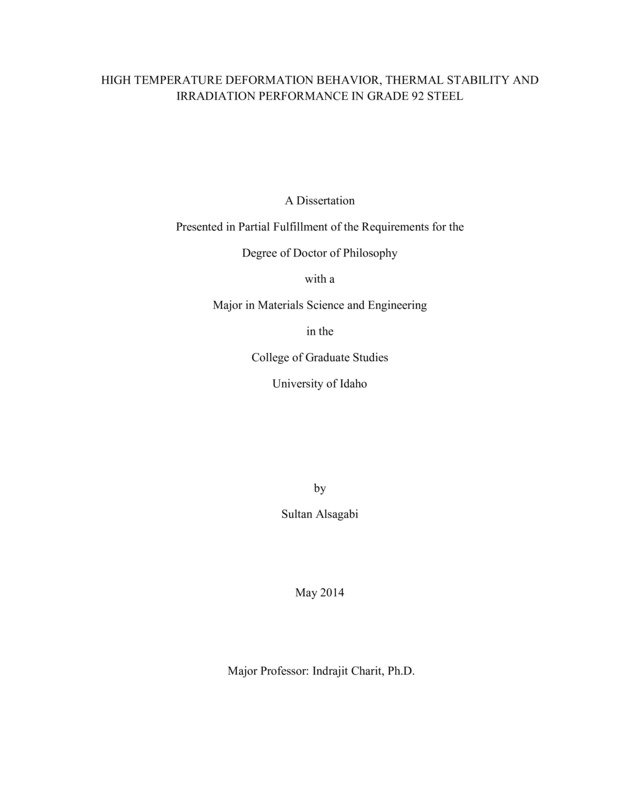HIGH TEMPERATURE DEFORMATION BEHAVIOR, THERMAL STABILITY AND IRRADIATION PERFORMANCE IN GRADE 92 STEEL
Alsagabi, Sultan. (2014). HIGH TEMPERATURE DEFORMATION BEHAVIOR, THERMAL STABILITY AND IRRADIATION PERFORMANCE IN GRADE 92 STEEL. Theses and Dissertations Collection, University of Idaho Library Digital Collections. https://www.lib.uidaho.edu/digital/etd/items/alsagabi_idaho_0089e_10275.html
- Title:
- HIGH TEMPERATURE DEFORMATION BEHAVIOR, THERMAL STABILITY AND IRRADIATION PERFORMANCE IN GRADE 92 STEEL
- Author:
- Alsagabi, Sultan
- Date:
- 2014
- Keywords:
- hardening irradiation performance mechanical characteristics steel strengthening thermal stability
- Program:
- Chemical Engineering and Materials Engineering
- Subject Category:
- Materials Science; Engineering
- Abstract:
-
The 9Cr-2W ferritic-martensitic steel (i.e. Grade 92 steel) possesses excellent mechanical and thermophysical properties; therefore, it has been considered to suit more challenging applications where high temperature strength and creep-rupture properties are required. The high temperature deformation mechanism was investigated through a set of tensile testing at elevated temperatures. Hence, the threshold stress concept was applied to elucidate the operating high temperature deformation mechanism. It was identified as the high temperature climb of edge dislocations due to the particle-dislocation interactions and the appropriate constitutive equation was developed. In addition, the microstructural evolution at room and elevated temperatures was investigated. For instance, the microstructural evolution under loading was more pronounced and carbide precipitation showed more coarsening tendency. The growth of these carbide precipitates, by removing W and Mo from matrix, significantly deteriorates the solid solution strengthening. The MX type carbonitrides exhibited better coarsening resistance. To better understand the thermal microstructural stability, long tempering schedules up to 1000 hours was conducted at 560, 660 and 760°C after normalizing the steel. Still, the coarsening rate of M23C6 carbides was higher than the MX-type particles. Moreover, the Laves phase particles were detected after tempering the steel for long periods before they dissolve back into the matrix at high temperature (i.e. 720°C). The influence of the tempering temperature and time was studied for Grade 92 steel via Hollomon-Jaffe parameter. Finally, the irradiation performance of Grade 92 steel was evaluated to examine the feasibility of its eventual reactor use. To that end, Grade 92 steel was irradiated with iron (Fe
2+ ) ions to 10, 50 and 100 dpa at 30 and 500°C. Overall, the irradiated samples showed some irradiation-induced hardening which was more noticeable at 30°C. Additionally, irradiation-induced defect clusters and dislocation loops were observed and the irradiated samples did not show any bubble or void. - Description:
- doctoral, Ph.D., Chemical Engineering and Materials Engineering -- University of Idaho - College of Graduate Studies, 2014
- Major Professor:
- Charit, Indrajit
- Committee:
- Raja, Krishnan; Pesic, Batric; Potirniche, Gabriel
- Defense Date:
- 2014
- Identifier:
- Alsagabi_idaho_0089E_10275
- Type:
- Text
- Format Original:
- Format:
- application/pdf
- Rights:
- In Copyright - Educational Use Permitted. For more information, please contact University of Idaho Library Special Collections and Archives Department at libspec@uidaho.edu.
- Standardized Rights:
- http://rightsstatements.org/vocab/InC-EDU/1.0/

